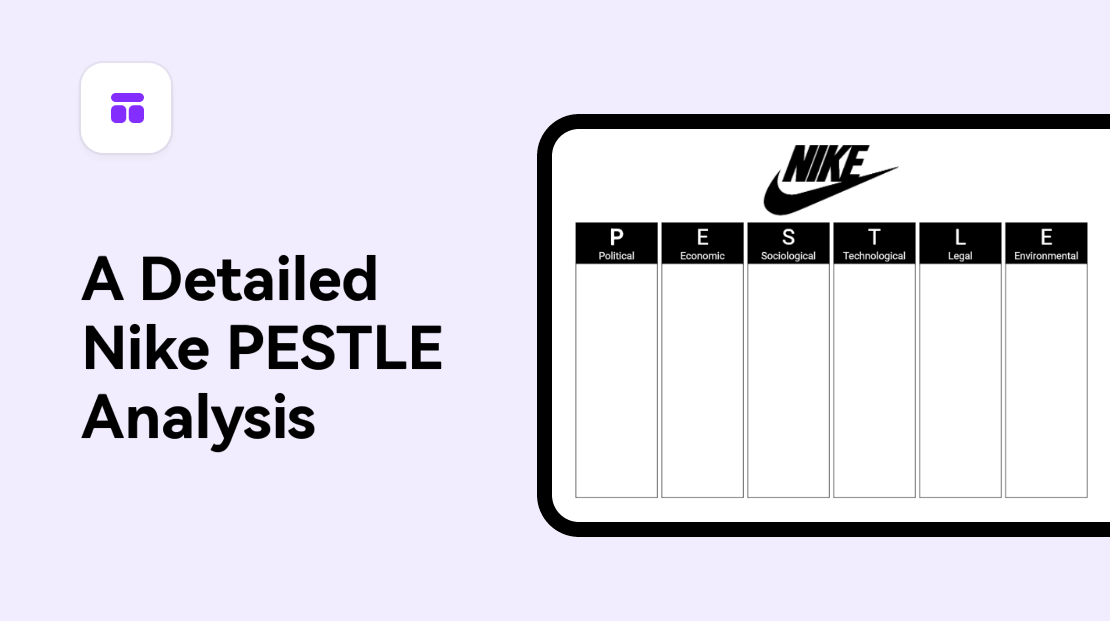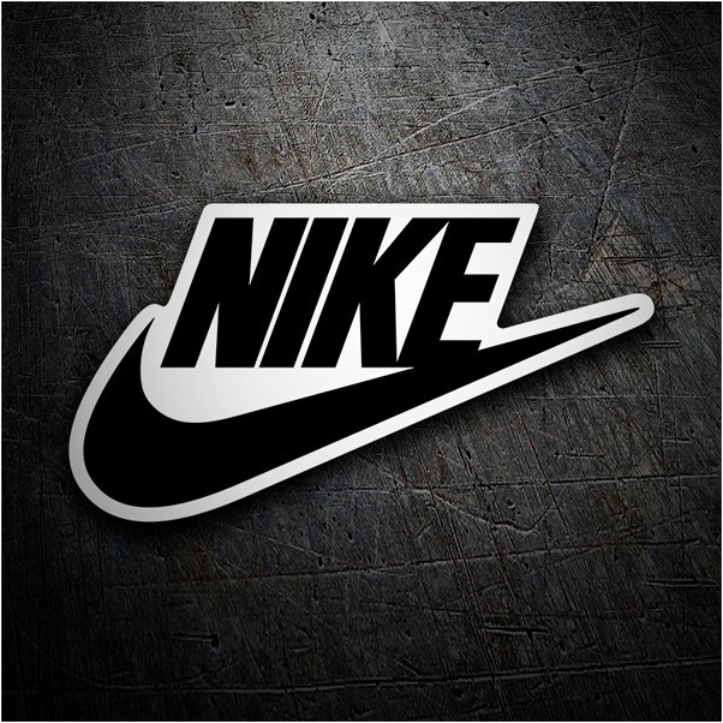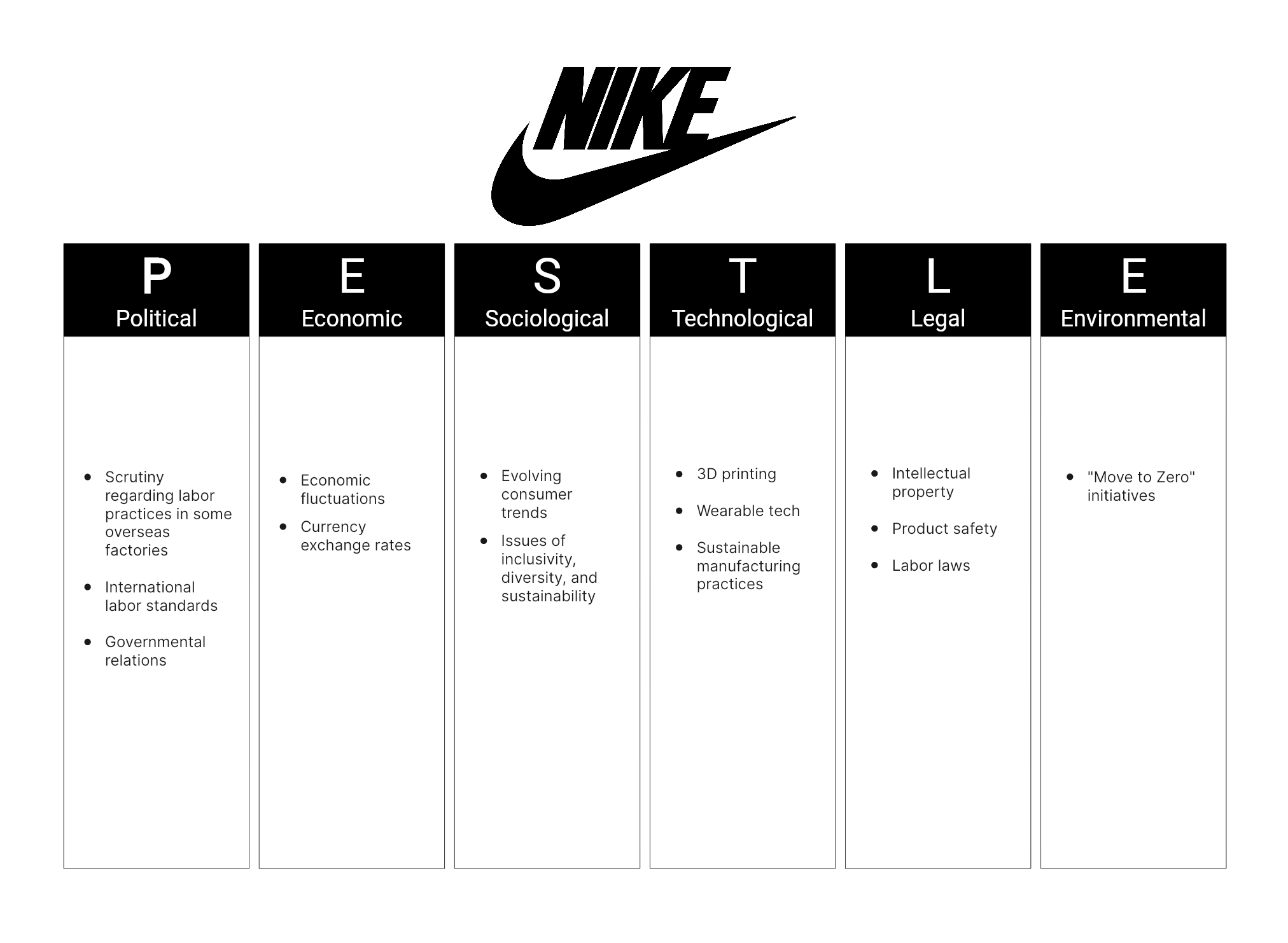As the global landscape of business continues to evolve, understanding the external forces impacting an organization is crucial for strategic decision-making. One effective tool for this purpose is the PESTLE analysis, which assesses various macro-environmental factors. In this article, we will conduct a comprehensive Nike PESTLE analysis, a prominent player in the sportswear industry.

What Is the PESTLE Analysis
The PESTLE analysis is a strategic framework that provides businesses with a powerful tool to navigate the complex landscape of external influences. PESTLE stands for Political, Economic, Socio-cultural, Technological, Legal, and Environmental factors, representing key dimensions that shape a company's operational environment.

- Political Factors: Government policies, stability, and geopolitical dynamics influence business operations. Considerations include trade policies, labor laws, and political climates.
- Economic Factors: Inflation rates, exchange rates, and economic growth impact consumer spending and market stability. Adaptation to economic fluctuations is crucial for competitiveness.
- Sociocultural Factors: Examining societal trends, demographics, and consumer behavior informs product development and marketing strategies. Aligning with cultural norms is essential for success.
- Technological Factors: Rapid advancements in technology necessitate innovation, automation, and staying current with tech trends. This dimension is pivotal for maintaining competitiveness.
- Legal Factors: Compliance with laws and regulations, intellectual property protection, and ethical business practices are vital for operating within legal bounds.
- Environmental Factors: Growing concerns about sustainability and climate change highlight the importance of environmental regulations, resource availability, and eco-friendly product offerings.
Basic Info of Nike
Nike, established in 1964 and headquartered in Beaverton, Oregon, stands as a preeminent global force in athletic footwear, apparel, equipment, and accessories. With a pervasive presence spanning over 170 countries, Nike's expansive product line caters to athletes, fitness enthusiasts, and fashion-conscious individuals alike. The brand's iconic swoosh logo has become synonymous with excellence, innovation, and style, solidifying its position as one of the most universally recognized and valuable sportswear companies worldwide.

At its core, Nike's mission is to "bring inspiration and innovation to every athlete in the world." This ethos extends beyond professional athletes to encompass anyone with a body and a passion for sports. With an unwavering commitment to cutting-edge technology and design, Nike consistently pushes the boundaries of athletic performance and fashion. This dedication has propelled the company to the forefront of the industry, making it a household name and an emblem of sporting excellence.
Nike PESTLE Analysis
Conducting a comprehensive Nike PESTLE analysis allows us to delve into the intricate web of external factors shaping the brand's operational landscape. This evaluation, focusing on Political, Economic, Sociocultural, Technological, Legal, and Environmental influences, provides valuable insights into how Nike strategically adapts to global dynamics.
In this section, we will conduct a comprehensive Nike PESTLE analysis:

Political Factors: Nike operates in a politically stable environment, but it faces scrutiny regarding labor practices in some overseas factories. Complying with international labor standards and maintaining positive governmental relations is essential for sustainable growth.
Economic Factors: Economic fluctuations can impact consumer spending on non-essential items like sportswear. Additionally, currency exchange rates can influence Nike's profitability in international markets, necessitating robust hedging strategies and adaptive pricing strategies.
Sociocultural Factors: Nike's brand image is deeply intertwined with sports culture, making it imperative to align with evolving consumer trends. Issues of inclusivity, diversity, and sustainability are also crucial in shaping consumer perception and loyalty.
Technological Factors: Continuous innovation in materials and manufacturing processes is a cornerstone of Nike's competitive advantage. Embracing emerging technologies like 3D printing, wearable tech, and sustainable manufacturing practices will be key to staying ahead in the industry.
Legal Factors: Nike, like many multinational corporations, faces legal challenges related to intellectual property, product safety, and compliance with labor laws. Ensuring adherence to stringent legal standards across various jurisdictions is paramount for risk mitigation.
Environmental Factors: Sustainability is a growing concern for consumers, and Nike has taken steps to address this through initiatives like "Move to Zero." However, the environmental impact of its supply chain and operations remains an ongoing challenge, necessitating continued efforts towards eco-friendly practices.
Insights from the Nike PESTLE Analysis
The comprehensive Nike PESTLE analysis reveals invaluable insights into the external forces shaping the sportswear giant's operational landscape. Here are key takeaways:
- Balancing Global Political Dynamics: Nike must maintain a delicate balance in navigating political environments worldwide. Adhering to international labor standards while fostering positive government relations is crucial for sustained success.
- Resilience in Economic Volatility: Economic fluctuations can impact consumer spending, emphasizing the need for Nike to implement adaptive pricing strategies and robust hedging mechanisms. This resilience ensures stability across diverse markets.
- Cultural Alignment and Adaptation: Remaining attuned to evolving consumer trends and aligning with sports culture is pivotal. Prioritizing inclusivity, diversity, and sustainability resonates strongly with consumers, bolstering brand loyalty.
- Innovation and Technological Integration: Nike's commitment to technological innovation is a cornerstone of its competitive advantage. Embracing cutting-edge technologies not only drives product development but also enhances sustainability efforts.
- Legal Vigilance and Compliance: Navigating the complex legal landscape is essential for multinational corporations like Nike. Stringent adherence to intellectual property, product safety, and labor laws mitigates legal risks and upholds ethical standards.
- Sustainability as a Core Imperative: Nike's "Move to Zero" initiative reflects a proactive approach towards environmental stewardship. However, ongoing efforts are required to minimize the environmental impact of its supply chain and operations.
Key Takeaway: A One-stop Tool for PESTLE Analysis
The PESTLE analysis serves as a powerful diagnostic tool, providing businesses with a comprehensive framework to assess external factors. For Nike, this means considering the Political, Economic, Sociocultural, Technological, Legal, and Environmental dimensions. By leveraging these insights, Nike can make informed decisions, adapt strategies, and position itself for sustained success in the ever-evolving sportswear market.
To create a PESTLE analysis suitable for your business, why not consider utilizing the one-stop whiteboard tool Boardmix? It can hold everything in your brain and inspire you at necessary phases using various templates, tools, features, and AI assistants. Just give it a try!









